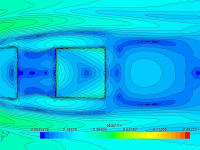Heavy trucks are considered aerodynamically inefficient compared with many of the other ground vehicles due to their unstreamlined body shapes with more than 60% of the engine power required to overcome aerodynamics drag at highway cruising speeds. In contrast a passenger car under the same driving conditions requires approximately 4 times less power from the engine to overcome aerodynamics drag. Therefore aerodynamic drag reduction is hugely important for trucks.
In order to understand aerodynamic drag around trucks, we need to understand the drag distribution and the associated flow field around a truck. The percentage of drag distributed around a truck usually slips with the front face of the truck generating a drag of 25%, the gap between the tractor and trailer generating a drag of 20%, the rear of the trailer generating a drag of 25% and the underside of the truck generating a drag of balance 30%.
This type of vehicles is used for transporting majority of the good across a country and an appreciable level of drag reduction can be achieved by adding simple add-on devices or by modifying the design. An experimental study on the aerodynamic drag of a simplified tractor-trailer was carried out and it was found that a significant drag reduction could be achieved when two different drag-reducing devices were employed. There have been many other studies on the use of drag-reducing devices but this study will be focusing on the flow field around two bluff bodies in close tandem, which is similar to the flow field in the gap between tractor and trailer in a truck. Many studies have been conducted for two-dimensional bluff bodies and a review has been provided by Rockwell. Experimental study on the drag variation of two square cylinder in a tandem arrangement and identified a sudden increase in the drag at a certain spacing between the two cylinders, denoted as the critical spacing. The spacing has a significant impact on the flow field around two square cylinders in a tandem arrangement. Identifying the existence of a critical spacing for two square cylinders in a tandem arrangement at which a sudden change in the drag occurred. Their results confirmed the findings of previous studies that the flow characteristics can be divided into two drastically different flow patterns separated by a critical spacing. There have been relatively fewer studies on three-dimensional bluff body geometries and the flow field around three-dimensional bluff bodies are inherently very complex with the formation of spanwise and streamwise vortices, which interact with each other too. It was shown in that the structure of the turbulent field in the cavity region was significantly different from that in a two dimensional
Like this entry?
-
About the Entrant
- Name:Terrance Charles
- Type of entry:individual
- Software used for this entry:Star CCM+
- Patent status:none








